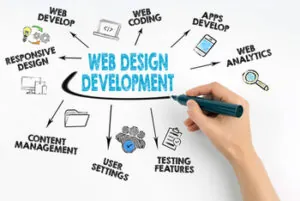In the ever-evolving web design world, keeping abreast of the latest trends is crucial for any business striving to maintain an edge in the digital landscape. The importance of a well-crafted website for dental practices cannot be overstated. It’s the first point of contact for many potential clients and can significantly influence their perception of the service.
In this article, we delve into several web design trends that are particularly suited for dental websites, ensuring that your site looks modern and professional and resonates with your website visitors.
User-Friendly Interfaces: A Necessity for Modern Web Design
In contemporary web design, emphasising user-friendly interfaces is not merely a trend but a fundamental requirement. This aspect is particularly crucial for dental websites, where clarity, ease of navigation, and accessibility are key to ensuring a positive user experience. Let’s delve deeper into this vital component of web design, focusing on its significance and implementation.
Simplicity and Clarity: The Cornerstones of User-Friendly Web Design

To combat this, web designs should focus on clear, concise content and a layout that’s easy to navigate. This includes well-defined sections, straightforward menus, and a clean interface that guides visitors to the information they seek without unnecessary distractions.
Responsive Design: Catering to a Mobile-First Audience
With the increasing use of smartphones and tablets, responsive design has become a non-negotiable element of web design.
Dental websites must ensure their web pages are optimally viewable across various devices. This involves adaptable layouts, readable text without zooming, and accessible menus and buttons. The goal is to provide an easy experience for users, regardless of the device they’re using.
Engagement and Interaction: Beyond Basic Functionality
Emerging web design trends are leaning towards providing information and engaging website visitors. For dental websites, this could mean interactive elements like appointment booking features, chatbots for instant queries, or educational segments explaining various dental procedures.
Such interactive web designs provide utility and enhance user engagement, making the website more than just a digital brochure.
Speed and Performance: Ensuring a Smooth Experience
In the realm of user-friendly web design, speed and performance play a pivotal role. A slow-loading web page can deter visitors, negatively impacting their experience and your website’s effectiveness. Optimising images, leveraging browser caching, and minimising code are essential to ensure your website loads quickly and runs smoothly.
Accessibility: Designing for All
Accessibility in web design ensures that people of all abilities and disabilities can utilise your website. This includes considerations like text-to-speech compatibility, keyboard navigation, and content that’s easy to understand. Making your dental website accessible broadens your potential client base and demonstrates social responsibility and inclusivity.
In conclusion, creating a user-friendly interface for dental websites is about marrying functionality with aesthetics. It’s about designing web pages that are not only visually appealing but also convenient to navigate, responsive, interactive, fast, and accessible. These elements are vital in crafting a digital space that resonates with and effectively serves your website visitors, ultimately reflecting the professionalism and care inherent in your dental practice. By focusing on these aspects, you ensure that your website is not just a tool but an extension of your patient-centred approach.
Sci-Fi Inspired Design: Blending Innovation with Comfort
In the contemporary landscape of web design, the infusion of sci-fi-inspired elements represents a bold and innovative approach. This trend, especially prevalent in design trends for 2024, offers a unique blend of futuristic aesthetics and comforting familiarity. Let’s explore how this theme can be effectively integrated into dental websites, enhancing visual appeal and user experience.
Futuristic Aesthetics: Creating a Cutting-Edge Visual Experience
The essence of sci-fi-inspired design lies in its ability to transport website visitors to a world of innovation and advanced technology. For dental websites, this can be achieved through sleek, metallic colour schemes, streamlined layouts, and custom graphics that echo the precision and advancement of modern dentistry. These design elements curate a visually appealing and dynamic interface, suggesting a practice at the forefront of dental technology and treatment.
Interactive Features: Engaging Users in a Digital Journey
Incorporating interactive features is a staple of modern web design, particularly for e-commerce websites and platforms. Dental websites can adopt this trend by integrating interactive dental health guides, virtual tours of the clinic, or even educational games about oral care. These features make the website more engaging and provide valuable information in an interactive format, enhancing the overall user experience.
Custom Graphics: Personalising the Sci-Fi Theme
Custom graphics play a crucial role in tailoring the sci-fi theme to fit the unique brand identity of a dental practice. This could include bespoke icons that depict dental services or custom illustrations that blend dental imagery with futuristic motifs. The key is to strike a balance between sci-fi elements and a dental clinic’s comforting, professional atmosphere, ensuring that the website remains relatable and reassuring to patients.
Responsive Design for All Web Browsers
Ensuring these elements are seamlessly displayed across all web browsers is crucial in embracing sci-fi-inspired design.
This means testing the website’s responsiveness and visual integrity on different devices and browsers, ensuring that the futuristic design translates well across various platforms. This consideration is essential, particularly for e-commerce sites where user experience directly impacts conversion rates.
Balancing Innovation with Comfort
While the sci-fi theme is inherently innovative and forward-thinking, blending these elements with comfortable, patient-friendly aspects is important.

Integrating sci-fi-inspired design into dental websites is a daring yet rewarding venture. It blends futuristic design elements, interactive features, and custom graphics to curate a visually appealing and innovative interface.
However, the key to success lies in balancing these modern elements with comfort and accessibility, ensuring that the website remains welcoming and user-friendly. By adopting these design trends for 2024, dental websites can position themselves as cutting-edge yet caring, appealing to a broad spectrum of patients seeking the best in dental care.
Embracing Dark Mode: A Trend That’s Here to Stay
Adopting dark mode in web design isn’t just a fleeting trend; it’s a significant shift in how we approach user interface design.
Once considered a novelty, this feature has become a staple in creating user-friendly websites. Let’s delve into how dark mode is implemented in modern web design, particularly dental websites, and why it’s more than just an aesthetic choice.
Dark Mode: More Than Just a Colour Scheme
At its core, dark mode offers a visual layout where light text appears on a dark background. This web design trend, however, transcends beyond mere colour preferences.
For many users, especially those who spend considerable time on screens, dark mode provides a less straining and more comfortable viewing experience.
By reducing glare and blue light exposure, dark mode helps in minimising eye fatigue, making it a practical choice for both daytime and nighttime browsing.
Enhancing User Experience with Dark Mode
When users scroll through a website, their experience should be seamless and comfortable. Implementing dark mode in dental websites can significantly enhance this experience.
It allows for easier reading of information, be it dental procedures or appointment booking details, especially in low-light environments.
Moreover, dark mode brings an element of sophistication and modernity to the website, aligning with the professional and advanced image of a dental practice.
Dark Mode and Accessibility
A crucial aspect of user-friendly websites is their accessibility to various users, including those with visual impairments or sensitivities.
Dark mode can be particularly advantageous for users with specific visual needs, such as light sensitivity or certain forms of dyslexia.
Dental websites can cater to a wider audience by offering a dark mode option, ensuring that their online resources are accessible to all.
Implementing Dark Mode Effectively
The key to successfully integrating dark mode into web design lies in the balance. It’s not merely inverting colours but redesigning the elements to fit a darker theme.
This involves adjusting the colour palettes for readability, ensuring that images and graphics are visible, and maintaining the overall aesthetic appeal of the website.
When a user scrolls through the site, the transition between light and dark modes should be smooth, maintaining the integrity of the design and content.
Interactive Websites: Engaging Visitors Beyond the Surface
In digital presence, interactive websites have emerged as one of the top web design trends, revolutionising how users engage with online content. This trend is particularly pivotal for industries where building trust and providing comprehensive information is crucial, such as dental practices. Let’s explore how interactive websites transform the user experience and why they are essential in today’s digital landscape.
The Rise of Interactive Web Design

This shift is driven by the need to engage users more deeply, ensuring they consume content and interact with it.
For dental websites, this means moving beyond listing services and contact information to creating a platform where patients can actively participate and engage.
Engagement Through Customisation and Personalisation
One of the key aspects of interactive web design is the ability to offer customised experiences to users. This can be achieved through personalised content, interactive questionnaires, or even virtual consultations.
By providing these personalised touchpoints, dental websites can make potential patients feel valued and understood, increasing the likelihood of them selecting the practice for their dental needs.
Utilising Advanced Technologies for Enhanced Interactivity
Integrating advanced technologies such as AI, VR, and AR into web design has opened new avenues for interactivity.
For example, a dental website could use AR to show patients the potential results of cosmetic dentistry or orthodontics.
Similarly, AI-powered chatbots can answer common dental queries instantly, offering interaction beyond traditional customer service.
Educational Interactivity: Informing While Engaging
An interactive website for a dental practice can serve as an educational platform, engagingly offering informative content.
This could include interactive guides on dental hygiene, animations explaining dental procedures, or quizzes to test knowledge on oral health. By interactively educating patients, dental practices can position themselves as authoritative and trustworthy sources of information.
Social Proof and Testimonials: Building Trust Interactively
Incorporating interactive elements such as patient testimonials or before-and-after galleries can significantly enhance trust.
Allowing users to navigate through real-life stories, view patient results, and share their experiences can create community and trust around a dental practice.
Gamification: A Novel Approach to Engagement
Gamification is a growing trend in interactive web design involving game-like elements in non-game contexts.
Dental websites could utilise this by incorporating oral health challenges, rewards for regular check-ups, or educational games for children. This makes the website more engaging and encourages positive dental habits.
Accessibility and User-Friendly Design
An interactive website must also be accessible and user-friendly. This includes intuitive navigation, clear calls to action, and compatibility with various devices and browsers.
Ensuring that all users can interact with the website regardless of their technical skills is crucial in providing an inclusive experience.
Feedback Loops and Continuous Improvement
Interactive websites allow for real-time feedback from users. Dental practices can use this feedback to improve their online presence continuously.
Whether adjusting the interface based on user behaviour or updating content based on patient inquiries, this feedback loop is essential for keeping the website relevant and user-centric.
SEO Benefits of Interactive Websites
Interactive websites also offer SEO benefits. Engaging, interactive content can lead to longer visit durations and lower bounce rates, signalling to search engines that the website is useful to users. This can improve search rankings, making the dental practice more visible to potential patients.
Challenges and Considerations in Interactive Web Design
While the benefits of interactive websites are numerous, there are also challenges to consider. These include ensuring website performance remains high despite the complex functionalities and balancing interactivity with simplicity to avoid overwhelming the user.
Additionally, maintaining privacy, especially in the healthcare sector, is paramount.
Visually Appealing Landing Pages: Your Digital Front Door
In the digital age, a business’s first impression is often through its website, specifically its landing page. This is especially true for dental practices, where the need to establish trust and comfort with potential patients is paramount.
A visually appealing landing page isn’t just a superficial enhancement; it’s a critical component of your digital strategy, designed to captivate and retain site visitors. Let’s explore the intricacies of creating landing pages that are not only visually stunning but also strategically effective.
The Importance of First Impressions
The landing page is often the first point of interaction between a dental practice and its potential patients.
It sets the tone for the complete website and, by extension, the perception of the practice. A well-designed landing page conveys professionalism, attention to detail, and a patient-centric approach – all key elements in building trust with site visitors.
Design Elements That Matter
Creating a visually appealing landing page involves carefully blending various design elements.
This includes a harmonious colour scheme that reflects a dental practice’s calming and professional nature, high-quality images that showcase the facility and staff, and a layout that intuitively guides the visitor through the page. Each element must work in concert to create an inviting and informative experience.
Balancing Aesthetics and Functionality
While aesthetics are crucial, they must maintain the functionality of the landing page.
The ultimate goal is to guide site visitors towards taking a specific action, whether booking an appointment, learning more about dental services, or contacting the practice for more information.
Clear, concise calls to action, easy navigation, and fast load times are essential in converting visitors into patients.
Responsive Design for Enhanced User Experience
In today’s mobile-first world, a landing page must be responsive, ensuring it looks and functions flawlessly across all devices.
This responsiveness elevates the user experience and adds positively to search engine rankings, making it convenient for potential patients to find dental practice online.
Personalisation for Increased Engagement
Personalisation can significantly enhance the appeal and effectiveness of a landing page. By using information and analytics to understand the needs and preferences of site visitors, a dental practice can tailor the content, offers, and calls to action on the landing page to match the interests of its audience. This level of personalisation can lead to higher engagement and conversion rates.
Incorporating Social Proof
Including elements of social proof, such as patient testimonials, reviews, and case studies, can greatly enhance the credibility of a dental practice.
These elements help build trust with potential patients by providing real-life examples of the quality of care and service they can expect.
The Role of Visual Storytelling
A compelling narrative told through visuals can captivate visitors and communicate the ethos of the dental practice more effectively than text alone.
This storytelling approach can involve images, videos, or graphics that illustrate the patient’s journey, the friendly environment of the clinic, or the transformative results of dental treatments.
Continuous Testing and Optimisation
Creating a visually appealing landing page is a task that takes time to complete. Continuous testing and optimisation are necessary to ensure it remains effective over time.
A/B testing different elements, from headlines to images, can provide valuable insights into what resonates best with site visitors.
Ensuring Optimal Website Performance Across All Devices
In the digital era, a website’s performance is as crucial as its aesthetic appeal, especially for dental practices looking to establish an online presence. Optimal website performance across all devices is not just a recommendation; it’s a necessity. This ensures that whether a patient accesses your website from a mobile phone, tablet, or desktop computer, they experience the same efficiency and ease of use. Let’s delve into how dental practices can achieve and maintain this level of performance.
Responsive Design: A Foundation for Performance

It’s not just about shrinking content to fit a smaller screen; it’s about reorganising it to maintain usability and aesthetics.
For dental websites, this means ensuring that appointment forms, contact details, and service information are easily navigable and legible on any device.
Speed Optimisation: Enhancing User Experience
Website speed is an important component of user experience. Slow-loading pages can frustrate visitors, leading to high bounce rates and lost potential clients.
Dental practices must prioritise speed optimisation, which involves compressing images, leveraging browser caching, minimising the use of heavy scripts, and choosing a reliable web hosting service.
These technical adjustments contribute significantly to reducing load times, making the site more accessible to users with varying internet speeds.
Cross-Device Testing: Ensuring Consistency
Regular testing across different devices and browsers is essential. What works flawlessly on one browser or device might translate poorly to another.
Dental practices should conduct thorough testing, which includes checking the website’s appearance, loading times, and functionality on multiple devices and browsers to ensure consistency in user experience.
User-Friendly Navigation: A Priority Across Devices
The navigation of a website should be intuitive and straightforward, regardless of the device used.
This involves a clear menu structure, easily accessible contact information, and straightforward paths to important sections like services, booking appointments, and patient testimonials. A well-structured website aids in guiding visitors effortlessly to the information they seek.
Accessibility: Inclusive Design for All Users
Website accessibility is a legal requirement in many jurisdictions and a moral responsibility. Ensuring that your website is useful to people with disabilities is a crucial aspect of website performance.
This includes providing alternative text for images, ensuring keyboard navigability, and offering options for changing text size and contrast.
An accessible website broadens your potential client base and demonstrates your practice’s commitment to inclusivity.
Security: Safeguarding Patient Information
In the healthcare sector, website security is paramount, given the sensitivity of patient data. Implementing robust security measures, such as SSL encryption, regular software updates, and secure data handling procedures, is vital.
This protects patient information and builds trust with site visitors, who can be assured that their data is safe.
Monitoring and Analytics: Keeping Track of Performance
Continuous observation and analysis of website performance are crucial. Tools like Google Analytics provide insights into how users communicate with your website, which pages are most visited, and where improvements are needed.
Regular analysis allows dental practices to make informed decisions to enhance website performance continually.
Conclusion
While keeping up with the latest website design trends is important, it’s also vital to tailor them to suit your specific audience. Dental websites should create a calming, trustworthy atmosphere, using design trends to reinforce these feelings.
Whether through sci-fi-inspired elements that speak of innovation or interactive features that educate and engage, the goal is to make your site fresh, informative, and reflective of the high standard of care your practice offers.
As web designers continue exploring and innovating the latest web design trends, it’s exciting to see how they will evolve. The future of web design is not just about aesthetics; it’s about creating user-friendly, interactive websites that meet the specific needs of your audience. By embracing these design trends, dental websites can provide their clients with an informative, reassuring, and engaging online presence.
However, achieving this level of digital proficiency requires expertise and ongoing dedication. This is where Mediboost comes in. As specialists in digital solutions for dental practices, we understand the unique challenges and opportunities within the dental industry. Our team is equipped to elevate your online presence, ensuring your website looks great and performs exceptionally well across all devices, engaging and converting visitors into loyal patients.
Take the first step towards transforming your dental practice’s digital presence. Contact Mediboost at 1300 163 058 for a consultation to discuss tailoring a digital strategy that meets your needs and goals. Let us help you turn your website into your most powerful marketing tool. Call us today, and let’s create a digital presence that truly reflects the excellence of your dental practice.
References:
https://www.forbes.com/sites/forbestechcouncil/2022/02/11/16-pro-tips-for-boosting-website-speed-and-performance/
https://www.cnet.com/tech/services-and-software/best-web-hosting/



